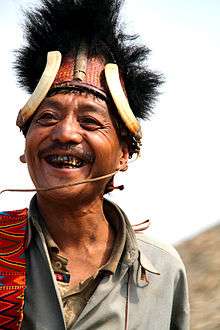Konyak people

KONYAK NAGA

The Konyak are a Naga people, and are recognised among other Naga by their tattoos, which they have all over their face and hands; facial tattoos were earned for taking an enemy's head. They are called the land of Angh's. They have the largest population among the Nagas.
The Konyak's festival "Aoleang" falls in the month of April from 1 to 6. Aoleang is the biggest festival for the Konyak. They wear their traditional attire and sing folk song to celebrate the Aoleang festival.
The Konyaks can be found in Myanmar, in the Tirap and Changlang districts of Arunachal, and in the Mon district of Nagaland, India. They are known in Arunachal as Wancho Konyak.
The Konyak language belongs to the Northern Naga sub branch of the Sal subfamily of Sino-Tibetan.
Known as head hunters of North East India. In the recent past, they were known as war loving and often attacked nearby villages of other tribes taking the heads of opposing warriors as trophies to hang in the Morong (a communal house). The number of heads indicated the power of a warrior and the tribe and becomes a collective totem. With the exception of these behaviors, the tribal members maintain a very disciplined community life with strict duties and responsibilities for every individual. Konyak is one of the richest in culture among the NE people's.
Further reading
- Stirn, Aglaja & Peter van Ham. The Hidden world of the Naga: Living Traditions in Northeast India. London: Prestel.
- Oppitz, Michael, Thomas Kaiser, Alban von Stockhausen & Marion Wettstein. 2008. Naga Identities: Changing Local Cultures in the Northeast of India. Gent: Snoeck Publishers.
- Kunz, Richard & Vibha Joshi. 2008. Naga – A Forgotten Mountain Region Rediscovered. Basel: Merian.
- Alban von Stockhausen: Imag(in)ing the Nagas: The Pictorial Ethnography of Hans-Eberhard Kauffmann and Christoph von Fürer-Haimendorf. Arnoldsche, Stuttgart 2014, ISBN 978-3-89790-412-5.